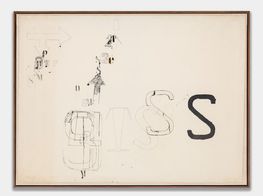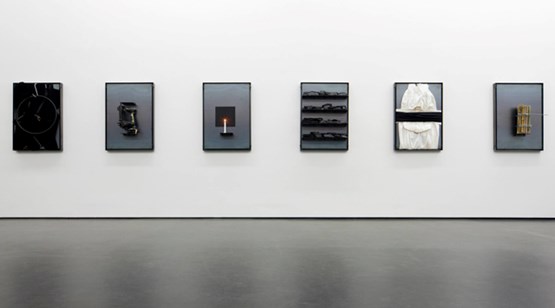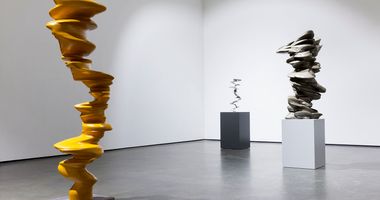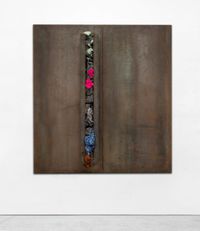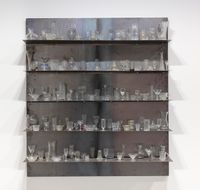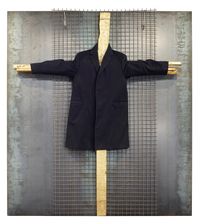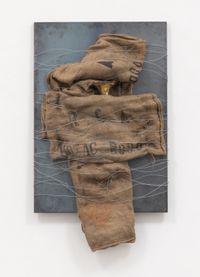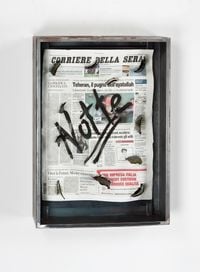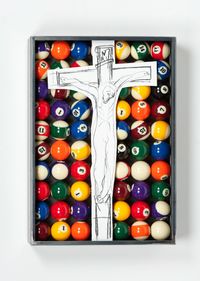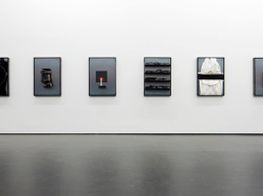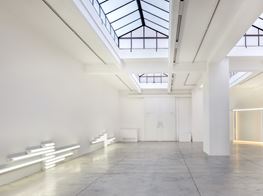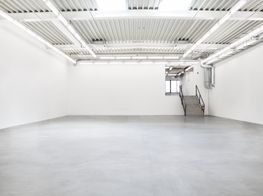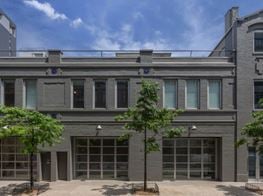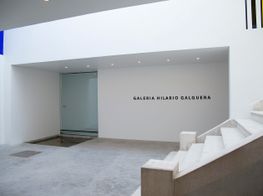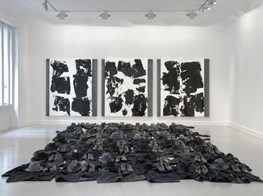Jannis Kounellis
Ocula Conversations.
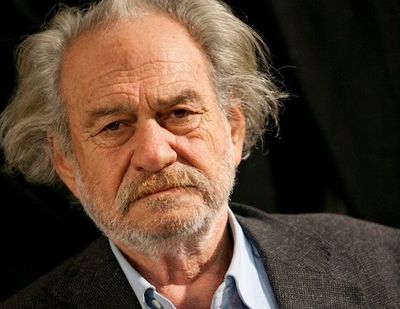
Ocula Conversations.
Born in Greece, but living in Italy since 1956, Jannis Kounellis has been a major figure in contemporary art for over fifty years.
The artist is often referred to as one of the forefathers of the Arte Povera movement—a movement that arose in the 1960s and played a central role in redefining artistic practice with radical and highly original sculpture, performance and installation. Influenced by artists such as Alberto Burri, Lucio Fontana, Jackson Pollock and Franz Kline, and both within the context of Arte Povera and outside of it, Kounellis has throughout his career interrogated and extended the boundaries of contemporary art, and in particular the possibilities of painting.
Although most of his works are three-dimensional and comprised of ready-made objects (sometimes even living objects—horses, birds and humans), Kounellis has always insisted he is a painter first and foremost. While still a student, Kounellis had his first solo show, titled L'alfabeto di Kounellis, at the Galleria la Tartaruga, Rome. The artist exhibited black-and-white canvases, which had stenciled numbers and letters on their surface, but otherwise demonstrated little painterliness.
During 1960 Kounellis began to introduce found sculptural objects such as actual street signs into his work, and that same year he wore one of his paintings and created a performance in his studio to demonstrate himself literally becoming one with his painting. The work, like much that followed, addressed both the realities and frustrations of contemporary society, while simultaneously considering primitive, fundamental, human values.
From the late 1960s onwards, found objects—sometimes physically and culturally antithetical to one another—such as earth and fire, burlap sacks and gold, were used in his work. Kounellis also started to use live animals—famously, in 1969, tethering horses to the exhibition space at Galleria l'Attico—thereby transforming the gallery into a stage where real life, exhibition and art could converge. People, too, began to enter his installations, adding a performative element to his practice. In the twenty-first century, Kounellis has continued to mine the world for new material possibilities, in each instance adding to a rich history of meaning within his practice.
Kounellis has been honored with major exhibitions at Galleria Nazionale d'Arte Moderna in Rome (2002), Museo d'Arte Contemporanea Donnaregina in Naples (2006), and Neue National Galerie in Berlin (2008), among others. His work is held in major institutional collections, including the Guggenheim, MoMA and Tate Modern. In recent years the artist has investigated architectural vocabulary, and his works appear increasingly sensitive to cultural, historical and site specificity.
In his recent exhibition at Wooson Gallery in Korea, where the artist has been resident, Kounellis has created individual works that directly speak to the gallery space and the Korean context in which they have been created. Ocula took the opportunity to interview Kounellis on his early work and also his current work on show at Wooson. His views on the role of the artist, and why he has always insisted on being called a painter.
Moving from the vastness of the space of the canvas directly to space, there are differences in how it's done, but the concept remains the same, the difference is that in the former show there were hermetic songs, in the latter the hermeticism is there but it's not necessary to sing it, the weight takes its place.
ADWhile still a student, you had your first solo show, titled L'alfabeto di Kounellis, at the Galleria la Tartaruga, Rome, in 1960. For this, you exhibited black-and-white canvases upon which you stenciled letters and numbers. Your most recent gallery exhibition opened at Wooson Gallery in Deagu, Korea. Can one trace the threads between the Kounellis Alphabet works and your most recent works at Wooson Gallery?
JKMy first show in Rome at the La Tartaruga gallery in 1960 was a hermetic rhythmic writing in space, the canvases were the size of the walls of my home at the time, they were cotton, stretched over the wall and painted white, then with the paint still wet I printed these letters and I sang something like a twelve-tone poem.
Today, moving from the vastness of the space of the canvas directly to space, there are differences in how it's done, but the concept remains the same, the difference is that in the former show there were hermetic songs, in the latter the hermeticism is there but it's not necessary to sing it, the weight takes its place.
ADOne of your most well known works is Untitled/ Twelve Horses, which you showed in Rome in 1969 and which involved you tethering horses to the gallery. Since then, you have continued to challenge the definition of what art can be. Now in an artistic environment where a work like Tino Sehgal's Guards Kissing can be purchased by a collector and donated to a Museum, where does the challenge lie for you?
JKCompared to American Minimalism, which had architecture as a model, the show of horses brings to the surface the emotional impact, the idea of space, it redesigns the basics of that exhibitive cavity which is a gallery, and it gives a dramaturgical dimension back to the artist who is no longer bound to objects.
There has always been someone who has bought a work and given it to a museum! This is nothing new, the challenge instead is to remain dialectical, otherwise internationality will not be understood, you always have to have another before you with whom you can dialogue, and this does not mean losing one's own identity, but rather understanding, as in the time of Hellenism, that the other represents a reality, and therefore a value.
ADYou have worked with an amazing variety of materials—live animals and human beings, music, coffee, burlap, steel and clothing. Yet, you have always described yourself as a painter. Why has this definition been important to you?
JKThe term "painter" is medieval, it refers perhaps to fresco painters.
It is not just the tonal picture that is painting, the cubists are painters, so is Franz Kline, Rembrandt is a painter but so are the constructivists, the medieval Christs are painting and Duchamp is also a painter. To define oneself a painter means having that tradition and that way of thinking, where freedom takes you, on its multicoloured sails, on mountain lakes and on oceans toward uncharted islands, this is painting, and each time it is unique and unrepeatable.
The artist has always been a visionary, and in many periods of history the dictatorships of various kinds that have populated the planet have tried to take away the artist's independence and freedom and to replace it with a political direction to tie it, with some excuse or another, to a propagandistic idea of the image.
ADFrom 1967 you became associated with the Italian art movement, Arte Povera, which was linked to contemporary political radicalism and in particular to the student protests of 1968. In recent years, we have seen riots in London, Istanbul and Greece. To what extent does your new work reflect on the current state of the world and address and criticise established institutions?
JKGoya was in Paris at the time of the French Revolution, the summary trials and the daily death sentences, and he wrote that he was struck by the fact that David had drawn the face of Marie Antoinette sitting in the cart that was carrying her to her death in a neoclassical manner, whereas in that scene he instead had only seen a grimace of fear on that face.
The 1968 movement began as a university protest but it never reached the degree of radicalness in the French Revolution's demand for liberty.
I have no desire to do sociological work, that doesn't interest me, I'm an old humanist, and for me man is an irreplaceable centrality and an open border. Moving away from this reality causes you to lose the vision of the future; we must not forget, however, that in the final analysis the problem is style, which is revolutionary or conservative, and that the new image must have the pathos of the old paintings.
ADYou have always held strong views on the role of the artist. What is the role of the artist in today's society?
JKThe artist has always been a visionary, and in many periods of history the dictatorships of various kinds that have populated the planet have tried to take away the artist's independence and freedom and to replace it with a political direction to tie it, with some excuse or another, to a propagandistic idea of the image. I think that the artist is the inventor of the new as an affirmation of freedom.
ADYour work was included in the legendary 1969 exhibition: Live in your Head: When Attitude Becomes Form, originally mounted at the Kunsthalle Bern by then director Harold Szeemann. At the time this exhibition was staged, did you sense that it would become so historically significant?
JKThe When Attitudes Become Form show brought together for the first time certain European and American experiences, allowing an entire generation of international artists to meet and compare their work, and in fact it initiated a time of exchanging of ideas that indicated the end of the postwar period.
I am interested in the weight of the materials, not in a phantasmagoric image, weight excludes the virtuality and the effect and leads you— with the complicity of smell—to have a real relationship with the world.
ADGermano Celant recently gave Harold Szeemann's exhibition a second life by re-staging it in Venice and calling it When Attitudes Become Form: Bern 1969/ Venice 2003. Your work was again included in this. Did you see the exhibition and if so, how did you view it's re-staging?
JKI haven't seen the show, but at a time when the economy acts as the only compass for qualifying artistic production, it seems to me that doing a show again from the 1960s, trying to respect its dramaturgical qualities can be—although risky—a critical indication worth evaluating.
ADTurning to your current exhibition in Korea. Perhaps you could explain the process of making the works for this exhibition?
JKI did not send from Italy the works showed in Korea; as is my habit, I went to the place not to photograph the landscape but to construct images with local materials, naturally using the stylistic intuition that in the '60s allowed me to set a live parrot against a sheet of iron.
ADIn one particular work you have juxtaposed the fabric of chima jeogari, which references traditional Korean dress, against a steel plate. In what other ways are the works in this exhibition relevant to the site in which they are shown?
JKI lived for a month in a traditional house in the Cheong Do countryside, there was rice everywhere, even on the streets, it was not a naturalistic image but with its epicness, it is the amount that becomes expressive and festive, and I did this, this rice festival could not escape me, I was excited and I created a work.
In the first room of the gallery on one wall I made 3 fans with my iron sheets, and on them I set, one by one, a coat, a hat and a stone; across from it 7 smaller metal sheets with 7 different materials including the Korean outfit held to the plate with a black cloth, in the middle a vermilion red square with 2 chairs on each side covered by a black cloth. The third room is like the beginning of a rhythmic dance with hundreds of dancers, in commemoration of a dancer who had a home on Olympus 2000 years ago.
ADI have heard you describe a work of art as being like a stone—you throw it into the water and watch the ripples. Is this what is important to you—not the art work itself, but how it affects art, people and the way the world is seen?
JKIn the '60s I did a work with 100 kg of coal resting against the wall of a public building, it could have been a gallery, a church, a factory, I am interested in the weight of the materials, not in a phantasmagoric image, weight excludes the virtuality and the effect and leads you— with the complicity of smell—to have a real relationship with the world. This of course does not exclude the complexity of Malevich's square. —[O]

